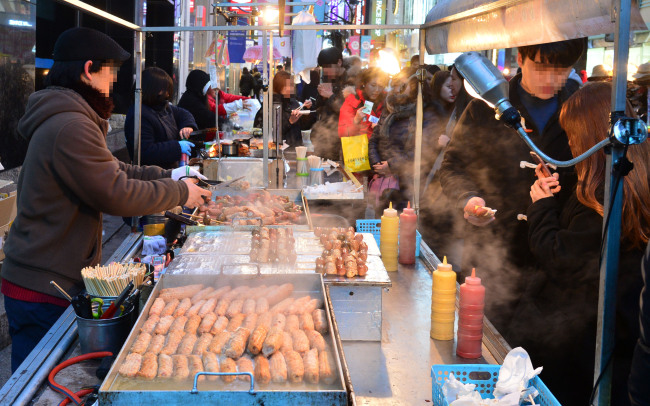Cheese-topped lobster, grilled steak, steaming bowls of Vietnamese rice noodle and deep-fried whole squid on a stick -- these are but some of the foods from around the globe that can be had on the go on Seoul streets.
Myeong-dong and Hongdae neighborhoods today boast street foods that have shed any trace of their humble origins as a cheap, quick bite for people short of money and time. Even staple street foods like tteokbokki and fishcakes have been given new twists -- spicy tteokbokki served smothered in melted cheese, for example.
Come dusk in Myeong-dong, a shopping district in the heart of Seoul, food carts begin to fill the main pedestrian streets. They are decorated with attention-grabbing whimsical signs: A cart selling grilled octopus is decorated with plastic octopus figures while plastic strawberries and Christmas lights hang overhead on a stall specializing in strawberry on a stick. Reflecting the area’s prominence as a tourist spot, the colorful menus are multilingual -- English, Chinese and Japanese, in addition to Korean.
It is not just the signs that are international -- the fare spread out on Myeong-dong streets hail from around the world. Looking at the number of churros stands, one might be led to believe the fried-dough pastry originated here.
 |
Myeong-dong bustles with carts offering various snacks. (Herald photo) |
Often, innovative entrepreneurs give new twists to classics -- as in croissant takiyaki, a combination of French pastry and traditional Japanese fish-shaped cake filled with red bean paste -- that please even the most jaded of travelers and palates.
In the Hongdae neighborhood, vendors go to great lengths to ensure that their foods are picture-worthy in this age of social media where a viral photo is worth more than a thousand words and means booming business. As the area known for its vibrant indie music and arts scene draws mostly young people, the street food offerings here include picture-worthy desserts.
Over at Noryangjin, once known for its thriving cup rice stalls that catered to the area’s cram school students, the relocation of the stalls to a designated street has dampened the business. At a weekday lunch hour, many of the 24 carts are closed and those that are open have few customers.
These vendors were moved to Noryangjin-ro 17-gil last October as part of the Dongjak-gu district office’s efforts to clean up the overcrowded pedestrian streets around the cram schools. The newly designated “cup rice street,” however, is seen as a failure by many of the vendors. “It is now too far from the cram schools. They won’t walk all the way here for a cup rice,” said a couple manning a stall that sells a basic cup rice at 3,000 won ($2.40) with toppings that can be added for 500 won to 1,000 won.
While the government promotes street foods as a tourist attraction, most of the vendors are illegal, and hygiene inspections are nonexistent, posing serious public health problems. Indeed, a general manager of a five-star hotel in Seoul noted that many of his guests who request doctors in the middle of the night complaining of stomachache have recently had street food.
Yet, such lack of oversight does not seem to bother tourists sampling street foods. To a Japanese tourist savoring scallops grilled to order at a stall in Myeong-dong, food safety was not a concern, although the Korean friend accompanying her said he might be concerned in the summer time. “The scallops are in the tank, but they don’t seem to be alive,” he said.
By Kim Hoo-ran, Hong Sung-pyo (
khooran@heraldcorp.com, (sphong@heraldcorp.com">
khooran@heraldcorp.com,
sphong@heraldcorp.com)







![[Today’s K-pop] Blackpink’s Jennie, Lisa invited to Coachella as solo acts](http://res.heraldm.com/phpwas/restmb_idxmake.php?idx=644&simg=/content/image/2024/11/21/20241121050099_0.jpg)
